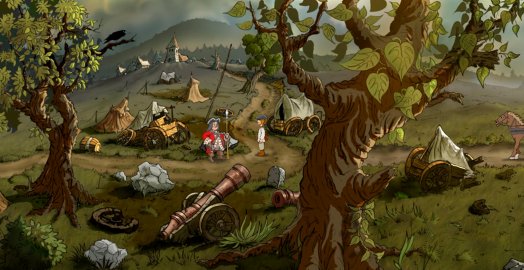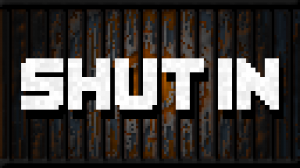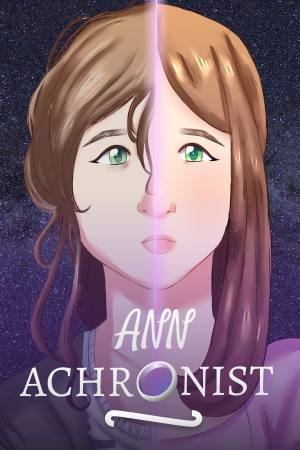Review for Krabat and the Secret of the Sorbian King

If, like me, you are not familiar with the Sorb people’s history and culture, you will get a taste of it while playing Krabat and the Secret of the Sorbian King. This should not be surprising as the game’s developer, Rapaki, was at least partially funded by the Foundation for the Sorbian People with the goal of educating players about the titular hero. It is not necessary to have any prior familiarity with Krabat to enjoy the game, however, as this is a purely fictional account of the legendary Sorbian figure who was referred to by the locals in his day as the person who sent the Dark Devil away. It’s not without its limitations, mostly notably a lack of English voice-overs, but this is a fun point-and-click adventure that should appeal to any fans of classic LucasArts and Sierra-style games.
Initially the lack of English dubbing is not an issue, as dialog is relatively brief, but as you progress through the game’s five chapters, many characters are introduced and interaction with them can involve a lot of extended conversation whose subtitles often disappear from the screen once complete. If you don’t speak hornjoserbsce (and I am willing to bet that most of you don’t), this means lots of reading, and quickly, so you don’t miss anything being said. In many cases, clues to puzzles are contained in these exchanges, and at times I struggled to keep up. Fortunately, in cases where you are given a lot of information germane to the story, you can ask the character speaking to repeat those details. Still, the lack of English voice-overs is one of my few significant quibbles, though I can appreciate the challenge of localizing a text-heavy game with a limited budget.
While I did not understand what was being said, I can safely say that the voice acting is not very good anyway, particularly when it comes to speaking with animals. For example, when talking to a cow the actor will say a very corny, “moo, moo” at the end of each sentence. The same thing happens when talking to a raven with a “caw, caw” finishing each line, pigeons with “coo, coo” and so on. I couldn’t tell if the writers were going for laughs or for realism, but it just fell flat. Krabat’s voice sounds satisfactory otherwise, if without much emotion, which is good as he has a lot to say. It is not possible to disable voices, but fortunately you can skip a sentence if you have heard it before. (Correction: According to the developers, it is indeed possible to disable voices by clicking to grey out the highlighted language in the game's settings.)
The story begins in the year 1714 with Krabat arriving, in a great hurry, at the Moritzburg Castle Hunting Lodge via a flying horse and carriage (which is never fully explained) to meet with Augustus II The Strong. It turns out a whole regiment of brave, strong and very well-trained Saxons have gone missing after setting up camp in Hochkrick (between Dresden and Poland). Only a mysterious paper was found stating, “The Sorbian King’s army has returned.” Because you know the people and territory so well, Augustus orders you, whom he describes as a “boy who pulls rabbits out of a hat at children’s birthday parties” even though you are actually a fully grown young man, to investigate the disappearance of the Saxons and the existence of the King.
At the abandoned campsite, you’ll gain control of your character and learn the point-and-click mechanics. While there is no in-game tutorial, the main menu (accessed via an icon at the bottom right of the screen) provides basic information on the interface, though it’s all very straightforward. The cursor is a feather icon that glows when you pass over hotspots. You can also reveal hotspots by holding down the space bar, or clicking the on-screen “?” icon. When you click on an interactive object, you will get a text description and sometimes Krabat will comment as well (if appropriate). Clicking on a person or animal will trigger either a monologue or the beginning of a conversation. As with the flying carriage, it is never fully explained how you can talk to animals, but it seems as if it has to do with your reputed ability to perform magic. Important clues are revealed by talking to them, so be sure to interact with all you encounter.
You can hold down the left mouse button when hovering over any hotspot to reveal both eye and hand icons, selecting one or the other to look at or interact. In most cases you only need to right-click to automatically trigger a default action, but for one puzzle you will want to see a description of each interactive element to solve it. You can quickly leave the current area by clicking an arrow at the edge of the screen, but walking within a given location is fairly slow and cannot be adjusted. Many scenes will scroll to the left or right, so you’ll want to always explore fully to make sure you aren’t overlooking anything. Game progress is autosaved when you exit to the main menu, but there is also the ability to save manually to one of seven slots. I highly recommend the latter, as I found that when I restored from a checkpoint I needed to replay a fair chunk of the game to get back to where I was.
The puzzles are by far the strength of Krabat and the Secret of the Sorbian King, with all but two of them solved through inventory use. Just click on the knapsack in the bottom left corner to reveal your collected items across the top. You can left-click on each one to get a description, and in rare circumstances you can combine two to create something new. One twist is that you can use some inventory items on yourself, which is necessary for solving some of the puzzles. A nice touch is an animation that shows when Krabat acquires or retrieves an item; he will add it to or remove it from his satchel regardless of how ridiculously large it may be. Most adventure games don’t bother with this level of detail, so it was refreshing to see the extra effort made for what is otherwise an often preposterous action.
There are a LOT of items to collect, often to overcome obstacles that require great lengths to solve, which I found quite fun. For instance, you need to gather multiple pieces of moss, some of which will introduce a whole new additional puzzle layer to acquire. Most are well-clued, but there are some exceptions, mainly due to translation issues. A good example is one of the two non-inventory puzzles, a tile challenge in the cathedral in which you need to select three out of twenty-five tiles with a combination of pictures and numerals on them and a caption above that says “For decades H.S. has been watching out for Lustatia. Now I’ll be watching over him at the highest source for centuries.” H.S stands for Hober Sprjewnik, who is a giant in the Sorbian folklore. When you look at the tiles, however, this clue is of no help, and since there are so many possibilities you cannot use brute force unless you get very lucky. I ended up contacting the developer for help, which I will share with you here (not a spoiler, just a necessary hint): “You will find H.S. at the three springs in the mountains.” The only other non-inventory puzzle is the need to duplicate dance moves in the pub at Bautzen, which is basically just a trial-and-error effort until you get it right.
Your first clue to the disappearance of the soldiers comes as you investigate the crime scene. After finding out that one of them survived the battle but was badly wounded and taken to the plague-ridden town of Bautzen, you head off to find him. There a nobleman named Ulfbert tries to frame Krabat for the missing soldiers and needs to kill the injured man before he can tell anyone the truth of what happened. He sends his lackey, Matthew, to do his dirty work, and you will run into Matthew a few times, occasionally seeing him skulking in the background, up to no good. He was clearly designed for comic relief, as he stutters nervously when he talks and usually ends up getting hurt in a comical way. In one scene he is stung by bees, for example, and in another he slips and falls down a ramp. It was a lot of fun watching to see what would happen whenever he showed up.
The ongoing plot is revealed through cutscenes along the way. While it is a bit light for an adventure game, it suffices to explain what has happened and why, and is revealed gradually so as to keep you guessing until the end. It becomes clear that a certain character is plotting to destroy Augustus II and become the King of Saxony, and it is up to you to stop him. (Be sure to wait past the credits at the end to see what happens to him and his henchman.) A more intricate story would have been nice, but perhaps anything more elaborate would have detracted from the goal of educating players on Sorbian culture and history.
To that end, there are many interesting and varied locations here, populated by lots of different characters. In the town of Bautzen you will travel to a pub (and try to win a dance competition), a cemetery, a church and a hospital, among some of the many areas available. You’ll also ascend to a mountaintop to summon an ancient giant, explore a forest, visit a country village, and paddle through a swamp.
Each scene and character is depicted with lovingly drawn, brightly coloured cartoon-style graphics. While very different games overall, Krabat and the Secret of the Sorbian King reminded me of the Monkey Island series in several respects. Krabat himself reminded me somewhat of Guybrush Threepwood, as the hat he always wears looks like a pirate hat that gives off the same vibe as Guybrush. Cutscenes and character animation are well done, and here again I was reminded somewhat of the early LucasArts games, with higher resolution but less style. Even the main theme music is reminiscent of the The Secret of Monkey Island.
In your travels you’ll meet various townspeople, peasants, farmers, soldiers, and even ghosts. Most will give you information about their daily lives, personal histories and key locations to help to educate you about the area. In some cases you will be given clues to a puzzle, where to go, or what to do next. There are two characters in particular who represent some of the local folklore. They are dwarfs called Lutki who live under the earth and always speak in negation, such as, “We’re not Lutki, can’t you see that?” I enjoyed talking with them and gladly helped them rescue someone stuck in the ground.
Music is adequate and is sometimes location-specific. For example, in the cathedral you will hear a beautiful choir singing, while the graveyard is mournful and somber, and bells ring in the church courtyard. This really helps sets the mood for each area. The tune that plays over the main menu is very catchy, with emphasis on the flute (which is the instrument Krabat himself will pull out and play if you stay still too long), but for the most part the background score is heavy on drums and orchestral rhythms that usually have a Bavarian theme. This theme tends to repeat often and can get a bit annoying without the ability to turn it off, but it’s tolerable. Sound effects are effective but limited to such things as the whinnying of Krabat’s horse, birds singing and water flowing.
Despite the absence of English voice-overs and lacking the polish of its higher-profile inspirations, I really enjoyed the fifteen-plus hours spent playing Krabat and the Secret of the Sorbian King. In setting out to tell an educational story of their people and history, the developers have done a great job of wrapping it in a fun fictional adventure game in its own right. The presentation is stylish and the variety and volume of inventory items to collect for solving the many inventive puzzles made me feel nostalgic throughout. If you long for the days of classic adventures, do yourself a favour and play this game. You will be glad you did.





__large.png)
__large.png)






















